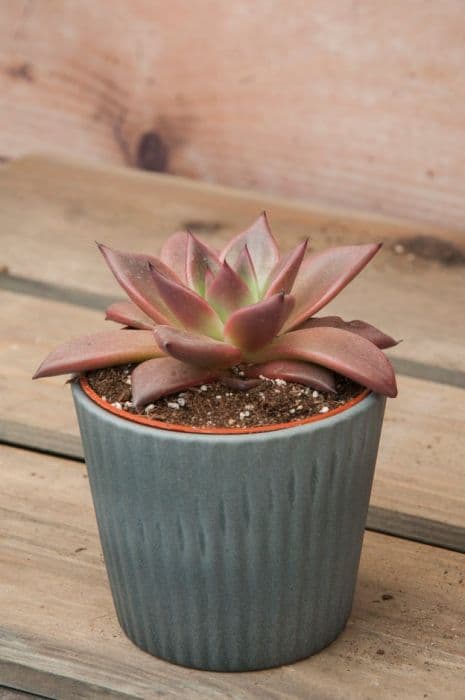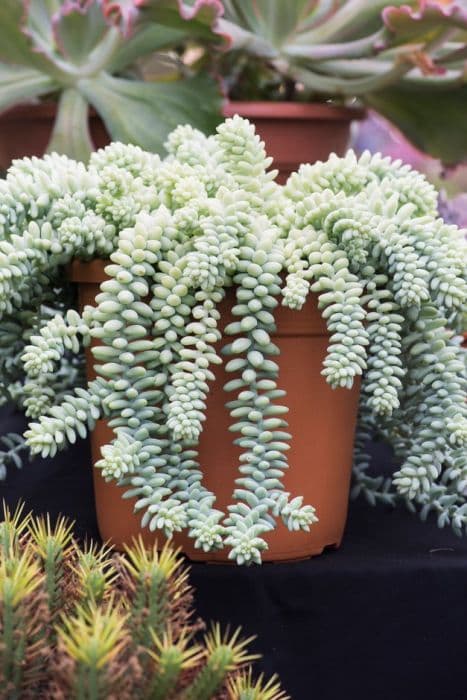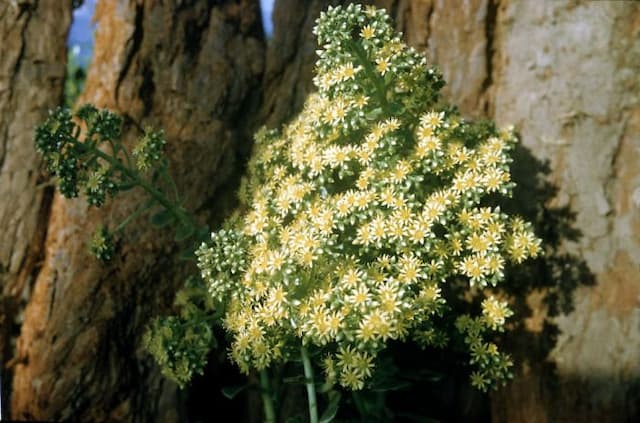Echeveria Red Echeveria × gilva 'Red'

ABOUT
The Echeveria 'Red' is a succulent that displays a stunning array of colors and a rosette growth pattern, which is characteristic of the Echeveria genus. The leaves are fleshy and have a waxy texture, contributing to their succulence. These leaves are arranged in a tight spiral, forming the rosette shape that can be quite dense and compact. Each leaf is smooth and paddle-shaped, coming to a gentle point at the end. A stand-out feature of this particular variety is its striking coloration. The leaves have a green base, but as they mature, they develop vibrant red or pinkish tones, especially around the edges and tips. The intensity of this red coloring can vary and is often more pronounced when the plant is stressed or exposed to certain environmental conditions, such as cooler temperatures or bright sunlight. Throughout the year, especially in the growing season, the Echeveria 'Red' may produce flower stalks. These stalks extend away from the main rosette and bear small, bell-shaped flowers. The flowers continue the plant's color palette, with red and yellow hues that attract pollinators. The overall look of the Echeveria 'Red' is both elegant and bold, making it a popular choice for succulent lovers and a striking addition to rock gardens, containers, or as part of a succulent arrangement. With its rich coloring and attractive rosette form, this succulent is a true gem among garden plants.
About this plant
 Names
NamesSynonyms
Red Echeveria, Gilva Echeveria
Common names
Echeveria × gilva 'Red'.
 Toxicity
ToxicityTo humans
Echeveria, generally speaking, is not considered toxic to humans. There are no significant symptoms associated with poisoning because these plants are generally regarded as safe. As a result, ingesting parts of Echeveria is unlikely to have serious consequences or toxicity in humans.
To pets
Echeveria is also non-toxic to pets. It is not known to cause any significant symptoms of poisoning if pets ingest any part of it. Consequently, the ingestion of Echeveria poses minimal risk of toxicity to household animals such as dogs and cats.
 Characteristics
CharacteristicsLife cycle
Perennials
Foliage type
Evergreen
Color of leaves
Red
Flower color
Varies
Height
6 inches (15 cm)
Spread
8 inches (20 cm)
Plant type
Succulent
Hardiness zones
9
Native area
Mexico
Benefits
 General Benefits
General Benefits- Low Maintenance: Echeveria 'Red' requires minimal care, making it ideal for busy individuals or those new to gardening.
- Drought Tolerant: Adapted to survive with little water, this succulent is great for water-wise gardens and reduces the need for frequent watering.
- Aesthetic Appeal: With its striking red-tinted leaves, Echeveria 'Red' adds a splash of color to any garden, windowsill, or room decor.
- Long Lifespan: Succulents like Echeveria 'Red' tend to have a long lifespan with proper care, offering long-term enjoyment.
- Pest Resistant: Resilient to most pests, this plant requires less treatment for pest control compared to more susceptible species.
- Easy Propagation: Echeveria 'Red' can be easily propagated from leaf cuttings or offsets, allowing gardeners to expand their collection without additional cost.
- Versatile: This type of succulent is suitable for a variety of planting arrangements like terrariums, rock gardens, or as part of a succulent wall.
- Tolerant of Poor Soil: Echeveria 'Red' can thrive in poor soil conditions, requiring less soil amendment and fertilization.
- Compact Growth: Its small and compact growth habit makes it ideal for container gardening and small spaces.
- Year-Round Interest: As a perennial, Echeveria 'Red' maintains its form and color throughout the year, contrasting nicely with other plants or as a standalone feature.
 Medical Properties
Medical PropertiesThis plant is not used for medical purposes.
 Air-purifying Qualities
Air-purifying QualitiesThis plant is not specifically known for air purifying qualities.
 Other Uses
Other Uses- Photography Prop: Echeveria can be used as a vibrant subject or backdrop for close-up photography, allowing enthusiasts to capture its rich color and symmetrical form.
- Art Inspiration: The natural rosette pattern and intense red coloration of the Echeveria serve as a muse for artists, inspiring paintings, drawings, and sculptures.
- Psychological Benefits: Cultivating Echeveria as a hobby can be therapeutic, offering a sense of accomplishment and stress relief through the care of these plants.
- Educational Tool: Echeveria are often used in schools or educational programs to teach students about botany, xeriscaping, and biodiversity.
- Fashion Accessories: Small Echeveria can be incorporated into living jewelry, such as brooches, necklaces, and crowns offering a unique, organic aesthetic.
- Wedding Decor: Because of their striking appearance, Echeveria are popular in wedding bouquets, table centerpieces, and as decorations for wedding cakes.
- Culinary Presentation: Chefs may use Echeveria to garnish plates and create visually appealing food presentations, though the plant itself is not edible.
- Seasonal Decor: Echeveria can be used as part of seasonal decor arrangements, integrating them into wreaths or as part of a fall centerpiece.
- Miniature Landscaping: Echeveria are suitable for fairy gardens or miniature landscapes, adding color and volume to these whimsical creations.
- Spacesuit Design: Researchers can study the resilience of Echeveria in extreme conditions, potentially influencing the design of biological components in future spacesuit iterations.
Interesting Facts
 Feng Shui
Feng ShuiThe Echeveria is not used in Feng Shui practice.
 Zodiac Sign Compitability
Zodiac Sign CompitabilityThe Echeveria is not used in astrology practice.
 Plant Symbolism
Plant Symbolism- Beauty: Echeveria, with its rosette shape and symmetrical form, is often associated with beauty and the perfection of nature.
- Resilience: As a succulent, echeveria symbolizes incredible resilience and the ability to thrive in harsh conditions by storing water in its leaves.
- Timelessness: With its slow growth and long life span, echeveria can represent timelessness and endurance.
- Adaptability: This plant's ability to adapt to various lighting conditions symbolizes flexibility and the ability to prosper in different environments.
- Enduring Love: The robust nature of echeveria and its perennial characteristics are often symbolic of enduring and persistent love.
 Water
WaterEcheveria 'Red' should be watered deeply but infrequently, allowing the soil to dry out completely between waterings. Typically, this means watering once every 7-10 days during the growing season, and reducing frequency to once a month during the dormant winter period. It is best to water the plant at its base and avoid getting water on the leaves to prevent rot. Depending on the pot size, you might use between 8 to 16 ounces of water per watering session as a general rule, adjusting based on the plant's response and environmental conditions.
 Light
LightEcheveria 'Red' thrives in bright, indirect sunlight. Ideal conditions include placement in a south or west-facing window where the plant can receive at least four to six hours of sunlight daily. However, it should be protected from the harsh midday sun to prevent leaf scorching.
 Temperature
TemperatureEcheveria 'Red' prefers a warm climate with temperatures ranging between 65 to 80 degrees Fahrenheit. It can tolerate a minimum temperature of about 40 degrees Fahrenheit but should not be exposed to frost. The ideal temperature to maintain this plant's health and color is around the 70-degree Fahrenheit mark.
 Pruning
PruningEcheveria 'Red' generally requires minimal pruning, mainly to remove any dead or damaged leaves to maintain its appearance and health. Pruning is best done in the spring or early summer when the plant is actively growing. Simply gently pull away any dry leaves from the base, and trim off any unsightly or dead parts with clean, sharp scissors.
 Cleaning
CleaningAs needed
 Soil
SoilEcheveria 'Red', commonly known as Echeveria, thrives in a well-draining soil mix with one part potting soil, one part perlite or pumice, and one part coarse sand. Aim for a slightly acidic to neutral pH of about 6.0 to 7.0 for optimal growth.
 Repotting
RepottingEcheveria 'Red' should be repotted every two to three years or whenever it outgrows its current pot. Ensure the new pot is slightly larger and has ample drainage holes.
 Humidity & Misting
Humidity & MistingEcheveria 'Red' prefers dry conditions and does well with low humidity levels typical of indoor environments. Avoid high humidity to prevent rot and fungal diseases.
 Suitable locations
Suitable locationsIndoor
Place Echeveria 'Red' in bright light, avoiding direct harsh sun.
Outdoor
Full to partial sun, protect from frost and heavy rain.
Hardiness zone
9-11 USDA
 Life cycle
Life cycleEcheveria 'Red' starts as a seed, germinating in well-draining soil with adequate warmth and light. It progresses to the seedling stage, developing fleshy leaves in a rosette pattern characteristic of Echeveria species. As it matures, the rosette grows larger and may produce offsets, or "pups," that can be separated to propagate new plants. Once mature, it enters a flowering stage, typically in the spring or summer, sending up a stalk with bell-shaped flowers that are often orange, red or yellow. After flowering, the plant may go through a period of dormancy, especially if grown in a climate with cooler winter seasons. Finally, after many years, the plant reaches the end of its lifespan and dies, though it often leaves behind numerous offspring through offsets and seeds.
 Propogation
PropogationPropogation time
Spring-Summer
Echeveria gilva 'Red', commonly referred to as Echeveria, is best propagated through the use of leaf cuttings. To do this, a healthy leaf is gently twisted off the plant, making sure that the entire base of the leaf is intact. After removal, the leaf should be left to dry for a period of days to allow the wound to heal and callous over. Once the end is calloused, the leaf can be placed on top of a well-draining soil mix and kept in a warm location with bright, indirect light. Watering should be minimal, only enough to moisten the soil without making it soggy, as too much water can cause the cutting to rot. In time, the leaf will sprout new roots and eventually a new rosette will form at the base of the cutting, gradually developing into a full plant. Typically, this process is most successful when performed in the warmer months, spring or early summer, to align with the plant's natural growth cycle.








![Takeshima stonecrop [Atlantis]](/_next/image?url=https%3A%2F%2Fplants-admin.emdemapps.com%2Fimages%2Fplants%2F%2Fimages%2F604b5470cdde2.png&w=640&q=75)
